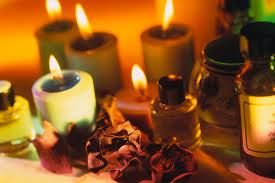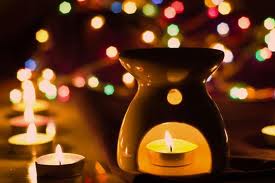Aromatherapy

For more than 4000 years man has learned to extract the aromatic essences and use them for various purposes. Several people ancient as the Egyptians, Greeks, Babylonians, Chinese and Indians, among others, had the custom of burning incense in the presence of the King, Priests or in front of sacred objects. Special and particular species were used to dispel the negative appearances and to evoke the favor of the gods, or to allow people to reach higher levels of awareness. It was in every case of important situations and solemn, as the species were considered valuable, given the difficulty that require their removal.
But, in addition to religious rites and burial, burning incense was also a form of protection against the plague or other diseases, so it was already known value therapeutic or even preventive, aromatherapy. Essences were used to correct the imbalance was to harmonize the energy to clean and to purify environments to provoke states of relaxation or stimulation.

In the ancient world the line between medicine and magic was very thin and remained so until the Middle Ages, during which the herbs typical of the Mediterranean basin, such as sage, basil, mint, rosemary, thyme ... etc., were included in prescriptions, as well as magic formulas.
Finally, essential oils, also known as essential oils, extracts from some spices were wanted for their aphrodisiac effects, here are some examples. Nutmeg, the core of an Indonesian fruit contains an essential oil exciting, whose main component, the myristicin, is behind the 'MDA, the "love drug" of the 70 Americans. The oil extracted from the leaves of cinnamon, as well as being a popular remedy for colds, it rubs on the genitals purpose of erotic stimulation, also according to legend, the drink was an aphrodisiac ingredient of Tristan and Isolde. The essence of vanilla, which is released from the fermentation of the fruit crop and was already used by the Aztecs, it would be able to fight sexual asthenia without risk to health. In 1762 a German doctor, Zimmerman, said in his Book On Experiences to have experienced the effectiveness of the plant and declared cured 342 men impotent.
The alchemists, thanks to their sophisticated purification processes, began a more detailed study on the nature of essential oils, but also seized the analogy between the plant species that are released by the source material and the "essence" of man, namely the psyche.
The aromatic essence is the most advanced component of the plant world, the soul of the plant is , contains his " personality", not surprisingly the word essence, in philosophy, signifies the most intimate and deep of a being.
The essential oil consists of molecules, it is still matter, but highly purified and refined, is the information that acts as an intermediary between the material world and spirit.
In the Renaissance and up to 700 spread the medicinal use of essential oils and cosmetics, but with the advent of 'Enlightenment and the scientific revolution, it took us only to study the chemical composition of these substances, leaving aspects analog and spiritual. In the twentieth century came to the laboratory synthesis of aromatic molecules, which replaces the natural oils in the production of perfumes.
In the '50s, thanks to studies of the French school of Valnet was scientifically possible to recognize that natural essential oils have different properties and are valid in the treatment of various disorders, characteristics not found in synthetic essences. Here are the main properties of wood:
- antiseptic and antimicrobial (cloves, cinnamon, thyme, oregano, Melaleuca, lavender, neroli ...)
- antirheumatic and antineuralgic (rosemary, chamomile, verbena, juniper ...)
- insectifuge and parasites (citronella, bay leaves, cinnamon, cloves, camphor ...)
- expectorants (eucalyptus, myrtle, rosemary, lavender ...)
- antispasmodic (lemon balm, chamomile, basil, fennel ...)
- digestive (orange, fennel, cumin, mint, verbena ...)
- toning (rosemary, pine, basil, sage ...)
- stimulating sexuality (sage, savory, cinnamon ...)
- sedative and balancing (lavender, chamomile, rose , melissa, sandalwood, orange blossom ...)
- phlebotonic (cypress, geranium, sandalwood, Melaleuca ...)
- eudermic (Melaleuca, rose, rosemary, orange blossom ...)
But the latest findings in neurophysiology and Psiconeuroendocrinoimmunology explain how the species may also act at the level of the nervous system, affecting mental functions, mood and emotions.
molecules that compose them are volatile, that is now passing the gaseous state and are picked up from our nose, coming in contact with the nasal mucosa, rich in receptors, and thus with the nerve endings of the olfactory nerve. From here, the stimulus reaches the central nervous system. The brain recognizes and ranks the odors and essences, working as a transducer: the recognition an odor stimulates the limbic system, one of the most phylogenetically ancient, ancestral to the most authority and instinctive, such as flight, reproduction, survival. It also stimulated the brain areas related to emotions and memory.
This results in the secretion of hormones that reach the bloodstream to the body's cells.
This results in the secretion of hormones that reach the bloodstream to the body's cells.
As you can see, the whole process does not pass through the cerebral cortex, then it does not involve consciousness, a mechanism is totally unconscious, but as far as sight and hearing about the transition to the cortex is inevitable.
why often bind to an odor and when reactivated experience smell, odor judge good or bad depending on the cultural, social and type of event experienced.
why often bind to an odor and when reactivated experience smell, odor judge good or bad depending on the cultural, social and type of event experienced.
Our subconscious speaks in symbols and it is on the symbolic level that creates a bond between man and plant, not else can you explain how the ancients might know which essence to use in any situation, not having knowledge of biochemistry and endocrinology.
The first symbolic aspect is gathered by observing any plant: it encourages deep roots in the soil and leaves to the light, accumulating both the terrestrial and the heavenly energies and then turning them in colors and smells, before being available to ' man. Therefore, through the encounter with the essences wakes our ancestral link with the macrocosm. Of each plant, as well as the botanical, should be seen and symbolic aspects of energy, which are derived from how it grows, the environment in which it and its links with the macrocosm (planet governor, yin / yang ...).
From energy point of view, the essences act at the level of the etheric body and investigations have shown that about plants, flowers and trees in particular, have a very high-energy radiation similar to that adopted by the etheric body of man. This energy is also contained in essential oils, so it can use to recharge your aura. The subtle etheric essence of flowers and plants come into contact with the human energy bodies through the chakras, releasing these healing and harmonizing their energies.

0 comments:
Post a Comment